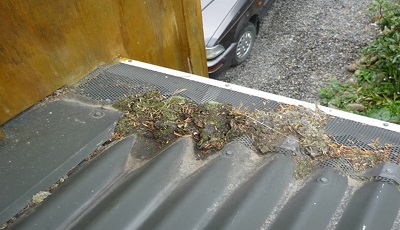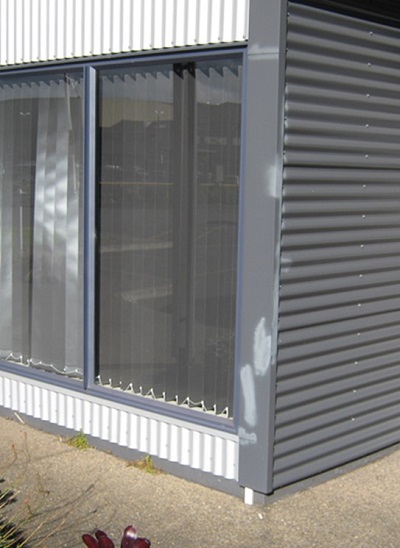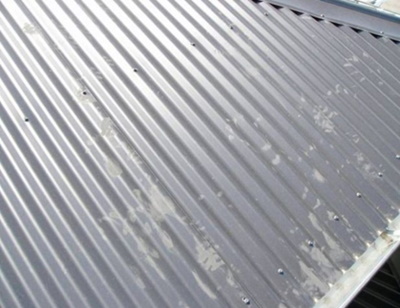COP v25.12:Installation; Avoiding-Problems
Excessive downforce on a rib or corrugated crest can cause a compression fold (dent or “ding”) in the apex of the crest.
Most roofs designed to Restricted Access criteria will incur some damage during installation or by subsequent traffic. If this is unacceptable, roofs should be designed to Unrestricted Access criteria and roof access and usage by other trades should be strongly managed and supervised.
A small ding in a sheet will not normally cause any structural problems and may be aesthetically acceptable; however, deeper dings can cause cracking of the sheet and lead to leaks.
To restore a damaged rib load capability to the original levels, all damage must be repaired with a cap flashing.
Ponding will create a prolonged time of wetness and increased build-up of debris. Ponding will detract from a coated steel product’s life and will invalidate the product warranty.
The installation of penetrations must be done in such a way that they do not cause ponding. See External Moisture: Penetrations.
On low pitched roofs, careless or excessive foot traffic may cause rib damage and localised ponding. This can be minimised by installing temporary protection in critical areas, such as entry points, where the roof is accessed by other trades, or there is a step-down in the roof. It is the main contractor’s responsibility to ensure that other trades do not damage the roof.
It is recommended to design to Unrestricted Access-criteria or better if roofs are highly visible or need to be regularly accessed by maintenance personnel.
Gutters must be installed with adequate fall to ensure water is transported to appropriately located downpipes. Falls and joints should be constructed so that water does not pond to a depth of more than 5 mm. Regular gutter cleaning and maintenance are required to remove leaves and other debris that may restrict water flow to downpipes. Vertical downpipes are parallel to the wall and adjacent vertical references, such as window jambs.
A gutter protection system (or any other product) that entraps debris or water between itself and any steel product surfaces, restricting coated steel’s ability to dry, is not recommended and is an exclusion in the product warranty.
Swarf is the term given to the metal debris arising from cutting or piercing operations when using friction saws, drills, or other tools on roofing and cladding products. In this context, swarf may also include any other discarded steel objects such as rivet shanks, nails, screws, and nuts which may come into contact with cladding products.
Steel swarf particles left on the surface will corrode and cause rust stains which will detract from the finished appearance of a project. These stains are often mistaken for early deterioration of the roofing and cladding itself. See 4.14 Swarf Staining and Cut Edge Corrosion.
- Cut only by shear; power shears or hand snips produce the least amount of debris.
- Power nibblers give a clean cut but generate debris which if left is prone to corrosion.
- Do not use metal friction blades or reciprocating saws which produce fine hot particles which can embed deeply into the coating surface and corrode rapidly.
If metal grinding is taking place near the surface of an installed or uninstalled roof, careful masking of nearby coated steel surfaces must be executed.
Swarf should be swept or hosed from the job progressively and certainly no less than at the end of each day. Swarf that has become stuck must be removed carefully, avoiding action which is likely to remove or change the appearance of the paint or metal coatings.
When sweeping or hosing into a gutter, clean out the gutter before leaving the job to prevent premature corrosion. On completion of the job, give a final wash or sweep down.
If the coating is severely damaged by swarf corrosion, the area should be painted or replaced. The whole visible area should be repaired, as air drying paints weather more rapidly and in a different manner to pre-painted roofing and cladding products. If swarf particles are painted over, rust bleed-through is likely to occur.
A common cause of swarf complaints arises because other trades have used grinding equipment in the vicinity of a newly completed roof. Wind carried swarf can contaminate large areas some distance from the cutting site. Main contractors should be aware of the likelihood of such damage, and project planning should include scheduling of all cutting or grinding work to be completed before laying the roof cladding.
Colour match paint is designed for matching accessories to the pre-painted material; it is not designed for repairing marks or blemishes. The term touch-up paint should never be used. Fasteners and accessories requiring colour matching should be painted before installation.
Air-dried paints used to disguise marks weather at a rate different from that of pre-painted material, sometimes dramatically so, and will often become more apparent than the mark they are intended to disguise. Minor scratches are best left alone, and they will not affect the performance of the pre-painted product due to the self-healing qualities of the primer and metallic coating. They become less evident as the coating weathers.
Minor scratches may be described as scratches that do not extend to the metallic coating, are less than 3 mm in width, and are not visually noticeable from a distance of 3 m. This characterisation will, however, vary with the concentration of the scratches, and the visibility of the area affected.
Extensive coating damage to any pre-painted steel product can only be rectified by replacement or repainting of the affected sheets.
Profiled metal roofing and wall cladding are readily paintable using good quality primers and water-based acrylic topcoats. Metallic coated roofs can be painted immediately after installation; however, dirt, grease, and any loose materials must be cleaned off, so the surface is clean and dry before applying the first coat.
An effective method for painting metallic coated roofing is to apply a good quality galvanised iron primer and two water-based acrylic topcoats, following the manufacturer’s recommendations.
Pre-painted products can be painted after exposure to weather. Normally, 6–12 months of exposure is required to achieve surface modification of the surface to allow the new coating to adhere.
Edge laps of unpainted metallic coated sheets steel do not require lap priming.
Sunscreen containing titanium dioxide or zinc oxide can accelerate the degradation of organic materials including auto finishes and pre-painted cladding surfaces. This damage is irreparable, so prevention of its occurrence is the only defence. For more information contact the material supplier.



